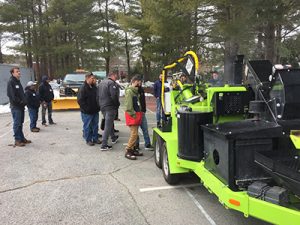Pavement faces many opponents including water, ice, salt, and debris. What’s the best defense? Crack sealing. But, successful results depend on a few factors—timing, material, application, and equipment.
The Right Time

Crack sealing is most effective when it’s performed as soon as cracks appear. Deferring the procedure will cause cracks to widen and spread causing more expensive, structural damage. When caught and treated early, the sealant provides a barrier to prevent water and non-compressible materials from entering the cracks which eliminates sub-base erosion, reduces freeze-thaw damage, and improves ride quality.
Being proactive is the first step. Next, consider the job. Where is it located and what type of pavement is it? This will help you determine the best material to apply.
The Right Material
Like sealers or traffic marking paint, not all crack sealants are the same. The type of sealant you use should be determined by the climate. For example, cooler climates require more flexible sealants than hotter climates. Using a softer material in a hot climate could cause tracking of the sealant by vehicle or pedestrian traffic. In hot climates, there is less movement of the pavement surface in general and, therefore, no need for a very flexible material. On the other hand, a flexible material is best for use in a cooler climate — where the pavement will be exposed to greater temperature swings and will have more thermal movement.
Another major factor is the job type. For example, you shouldn’t use a roadway sealant on a parking lot or pedestrian area. Parking lots require a sealant designed for pedestrian foot traffic, turning vehicles, and parked vehicles—usually a stiffer material that loses tackiness when cured. Pavements with less than 20 percent crack density require a more flexible sealant.
The Right Application
Only apply sealant in accordance with the manufacturer’s recommended temperature range, which is typically in air and pavement temperatures above 45°F. Also, be sure no rain is in the forecast.
Prior to installing sealant, widening of cracks or routing may be necessary. This process is recommended on roads with less than 20 percent crack density and can help extend the life of the sealant by up to 40 percent. When deciding between routing and sawing, study the pattern of cracking. Routing can be done with cracks in any direction, but sawing can only be done with straight cracks.
When sealing cracks in pavement with greater than 20 percent crack density, simple cleaning and sealing of the cracks is recommended.
The Right Equipment
To ensure the surface is clean and dry, use a compressor with sufficient pressure and velocity that is also equipped with a water trap to remove particles that could prevent bonding in the cracks.
A heat lance can be used to eliminate bond-destroying moisture. But, any pavement that is saturated with water shouldn’t be sealed. Areas that are damp, discolored due to moisture, or show evidence of frost or dew should be avoided during crack sealing.
With your melter/applicator, fill cracks no higher than 1/8 of an inch above the pavement to help prevent damage from tire imprint marks or snow plows.
For more information or help selecting material and equipment, contact your local GemSeal representative. We’ll help you take care of cracks and achieve the right results!


 Ken McBride /
Apr 2 , 2020
Ken McBride /
Apr 2 , 2020 


